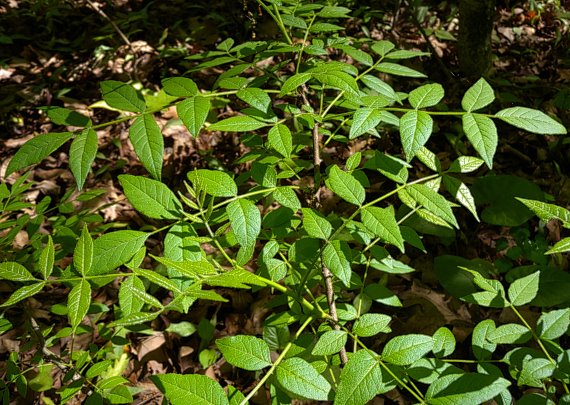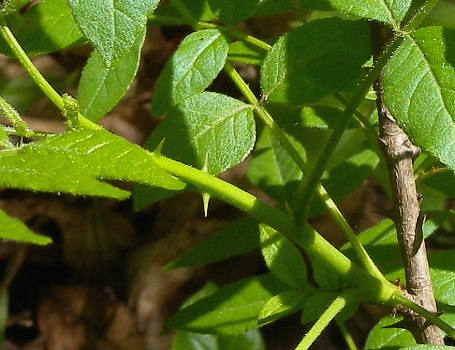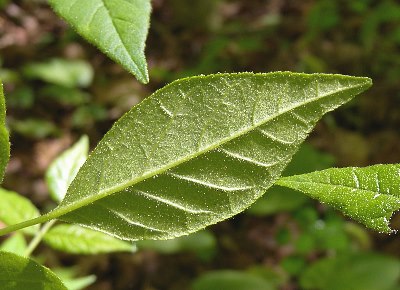
Prickly Ash is almost always dioecious, producing male (staminate) and female (pistillate) flowers on separate shrubs. These flowers are arranged in small axillary clusters (cymes) along the branches of the preceding year. Individual male flowers are a little less than ¼" across, consisting of 4-5 erect petals and 4-5 stamens; there is no calyx. The petals of male flowers are yellowish green to orange and oblong in shape. Individual female flowers are about ¼" across, consisting of 4-5 erect petals and 2-5 separate pistils; there is no calyx. The petals of female flowers are also yellowish green to orange and oblong in shape. The ovaries of the pistils are glossy green and ovoid in shape; their elongated styles tend to converge at their tips. The blooming period occurs during mid- to late spring before the leaves develop. Afterwards, the female flowers are replaced by berry-like follicles (fruits that open along one-side) about 1/3" (8 mm.) long that are ovoid-globoid in shape with a pitted surface. As the follicles mature, they change from green to red to brown, eventually splitting open to expose shiny black seeds with oily surfaces. Each follicle contains 1-2 seeds. Both the crushed foliage and fruits are highly aromatic, somewhat resembling the fragrance of lemon peels. The root system produces underground runners, from which clonal offsets are produced. This shrub often forms clonal colonies of varying size.

Cultivation: The preference is full or partial sun and moist to dry-mesic conditions. Different types of soil are tolerated, including those that contain loam, clay-loam, and rocky material. This shrub can adapt to light shade, but it may fail to produce flowers and fruit. It has relatively few problems with pests and disease organisms.
Range & Habitat: The native Prickly Ash is occasional in northern and central Illinois, while in the southern section of the state it is rare or absent (see Distribution Map). Habitats include upland woodlands, bottomland woodlands, savannas, wooded ravines, thinly wooded bluffs, edges of shady seeps, stream banks in wooded areas, thickets, pastures, and fence rows. Prickly Ash is found in both disturbed and higher quality natural areas. It probably benefits from occasional wildfires.

Faunal Associations: The nectar and pollen of the flowers attract primarily bees and flies (Robertson, 1929). Bee visitors include honeybees, bumblebees, cuckoo bees (Nomada spp.), mason bees (Osmia spp.), Halictid bees (Augochloropsis spp., Lasioglossum spp., etc.), and Andrenid bees (Andrena spp.). Fly visitors consist of Syrphid flies, Tachinid flies, Muscid flies, and others. The caterpillars of the butterfly, Papilio cresphontes (Giant Swallowtail), feed on the foliage of Prickly Ash. This shrub is the preferred host of the leafhopper Empoasca latarca (Dmitriev & Dietrich, 2010). Several polyphagous treehoppers also feed on this shrub: Cyrtolobus vau, Entylia bactriana, Hadrophyllus borealis, Stictocephala albescens, and Stictocephala taurina (Dennis, 1952). The fruits are sparingly consumed by birds and small mammals, including the Bobwhite Quail, Red-Eyed Vireo, and Eastern Chipmunk (Kurz, 1997/2004). These animals help to spread the seeds to new locations.
Photographic Location: A deciduous woodland near the Maumee River in NW Ohio. The photographs were taken during the late spring.

Comments: Prickly Ash is a distant relative of the Orange and other citrus fruits. In spite of its common name, it is not closely related to Ash trees (Fraxinus spp.) of the Olive family, although their pinnate leaves are superficially similar to each other. A more southern species, Zanthoxylum clava-herculis (Hercule's Club), differs from Prickly Ash by having its trunk densely covered with stout warty prickles. Hercule's Club also has more leaflets (11-19) per compound leaf and it produces large terminal panicles of flowers and fruit, rather than small axillary cymes of flowers and fruit. It is also possible to confuse Prickly Ash with a sapling of Robinia pseudoacacia (Black Locust) because they both have scattered large prickles along their twigs and smaller branches, and they both have pinnate leaves. However, Black Locust becomes much larger in size than Prickly Ash, it has more leaflets per compound leaf, its leaflets have more rounded tips, and its flowers and fruits are completely different in appearance. A scientific synonym of Prickly Ash, Xanthoxylum americanum, is occasionally encountered in some reference materials.